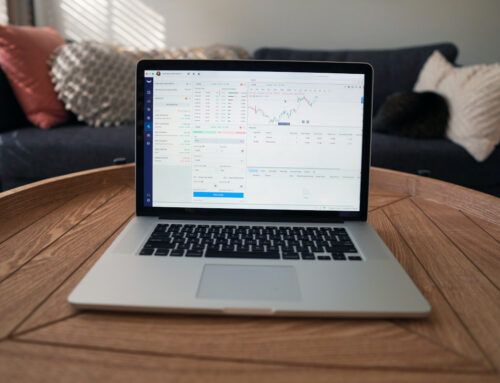There are so many different indicators that can help you gauge market sentiment, liquidity, and price trends – and today we’re going to introduce you to yet another: open interest.
Wait – what is open interest in options trading? This is a measure of how many open options contracts exist on the market at any given time. As new contracts are opened, the number rises. As contracts are closed, the figure falls. That means you’re able to use open interest as a way of watching how other market participants feel about a given asset.
But, there’s so much more to open interest that we have decided to dedicate an entire resource to the subject. Below, we’ll answer all your questions related to this topic – including why it is important, what a good open interest figure is for options trading, and additional advice on using it yourself in your own trading strategy. But first things first – exactly what is open interest in options trading?
What is Open Interest in Options Trading?
Open interest is an important concept in options trading that represents the total number of outstanding option contracts for a specific option series at any given time.
In simpler terms, it is the total number of contracts that have been bought or sold but have not yet been closed, exercised, or expired. Unlike volume, it doesn’t take into account contracts that have been closed. Because this theory can get a bit complex, we want to illustrate it through an example below:
- When a buyer and a seller initiate a new position by trading a contract, open interest increases by one.
- When a buyer and a seller both close their existing positions by trading a contract, open interest decreases by one.
- If an existing contract holder sells their position to a new buyer, open interest remains unchanged, as the transfer of the contract doesn’t create a new position.
Open interest provides valuable insights into the liquidity and trading activity of a particular option. You can use it whether you’re looking for an opportunity or managing an existing position. So to progress this conversation even further, let’s take a look at how open interest is used in options trading below.
How is Open Interest Used in Options Trading?
Regardless of your specific options trading strategy, you’ll need a means of keeping up with liquidity, market sentiment, and price trends. This is imperative for staying on the right side of trends and timing your position. And as it turns out, open interest can provide insights into all of these different factors. Here’s how…
- Liquidity: Options with higher open interest tend to have narrower bid-ask spreads and better liquidity, making it easier to enter and exit trades at favorable prices. On the other hand, options with low open interest may have wider bid-ask spreads and reduced liquidity, which can make it more challenging to trade profitably.
- Market Sentiment: Open interest can serve as an indicator of stock market sentiment for a particular option or underlying asset. Increasing open interest may suggest that new money is entering the market, indicating a growing interest in the option or the underlying security. Conversely, decreasing open interest may signal that traders are closing their positions, potentially reflecting a decline in interest.
- Price Trend: By analyzing changes in open interest alongside price movements, you can gain insights into the strength of a particular price trend. For example, if the price of an asset increases alongside rising open interest, it may suggest that the upward trend is gaining momentum, as more traders are participating in the market.
Obviously, open interest is a powerful tool to have in your stock analysis arsenal. But – what is a good open interest for options trading? As you’ll learn below, it depends on what your particular goals are and how you are trading the stock market…
What is a Good Open Interest for Options Trading?
First, understand that what’s considered good open interest to one trader will likely vary from the next. That’s because it all depends on the context of your trading strategy and the position you find yourself in.
With that said, most options traders look for instances of high open interest when getting into a position as it indicates ample liquidity should they want out. It also offers more efficient price discovery. On the other hand, if you’re looking to short a stock, you could use falling open interest as an indicator that a price trend is weakening and poised to head in the other direction.
However, open interest needs to be taken with a grain of salt and used in conjunction with other factors. For example, what is the underlying asset being traded? Because blue chip stocks are more heavily traded than less popular or thinly traded stocks, their open interest will be higher by default. But that doesn’t necessarily mean they have a stronger, more stable price trend than the other stock – they just have higher volume.
For more advice on actually using open interest in your trading strategy, keep reading below.
More Advice on Using Open Interest in Options Trading
That’s the basics on open interest for options traders – but before bringing this guide to a close, we want to leave you with a few more pieces of advice on actually using this indicator to your advantage.
- Track Options Chains: First, find option chains for the underlying asset you’re interested in trading. You can access option chains on financial websites, trading platforms, or through your brokerage account. This is where you’ll actually gain access to open interest insights – along with other pertinent information we’ll discuss below.
- Analyze Open Interest Levels: Once you have the option chain for your specific asset, analyze the open interest levels for various strike prices and expiration dates. Look for options with higher open interest, as these typically have better liquidity and narrower bid-ask spreads, making it easier to enter and exit trades at favorable prices
- Consider Trading Volume & Other Indicators: As mentioned earlier, open interest doesn’t paint the whole picture. You need to consider the relationship with trading volume as well. Moreover, you should use other technical trading indicators like moving averages to confirm whatever theories you develop through an analysis of open interest/volume.
- Identify Popular Strike Prices: If you’re writing options contracts or considering buying one, finding the proper strike price is key to setting yourself up for success. Open interest can help you here as higher open interest near specific strike prices may suggest that market participants expect the underlying asset to reach those levels. This information can help you select strike prices for your trading strategy.
- Monitor Changes to Open Interest: Keep track of changes in open interest over time, as this can provide insights into market sentiment and the strength of price trends. For example, increasing open interest alongside rising prices may indicate a strong bullish trend, while decreasing open interest during a price decline could signal a weakening bearish sentiment.
Looking for an Easier Way to Gauge Market Sentiment & Stay Ahead of Trends?
As you now know, you can use open interest in options trading to assess the strength of a price trend and help you time your entry and exit to perfection. As open interest declines, it suggests that whatever trend currently exists is on the brink of breaking.
But – what if there was an easier way to gauge market sentiment and stay ahead of trends? There is – the VectorVest stock analyzing software. This system relies on an intuitive stock rating system that has effectively called every major market move in the past few decades – helping our users stay ahead of trends.
One of the 3 ratings the system is based on is known as relative timing (RT) – and you can use it in the same way you’d use open interest to gauge the overall price trend. Using RT is much simpler, though, as it sits on a scale of 0.00-2.00, with 1.00 being the average. An RT rating rising above 1.00 indicates a strengthening price trend, whereas a falling RT below 1.00 indicates a weakening price trend. It’s really that easy.
And, that’s just the start of what VectorVest can do for you. You can find winning opportunities day in and day out through our proprietary stock screeners that bring the best stocks to trade on any given day right to your screen. See what’s possible by getting a free stock analysis today!
Parting Thoughts on the Meaning of Open Interest in Options Trading
There you have it – the meaning of open interest in options trading explained. So in summary, what is open interest in options trading?
This is a way of assessing liquidity, market sentiment, and price trends for an underlying stock or asset class. You can use it alongside other indicators like momentum or volume indicators to make the most informed decisions possible – including how to configure your options contract or when to buy/sell a security.
If you want to learn more about how to trade stock options, we encourage you to explore our blog for more resources related to how stock options work. In particular, you may be interested in our articles on when to sell stock options, how to short a stock with options, how to pick stocks for options trading, what happens when stock options expire, or how to manage risk for stock options.
But at this point, we encourage you to go seek out the options chains for any open positions you have and see what insights you can glean from open interest. Or, use it the next time you’re analyzing a potential opportunity to get a better sense of liquidy, market sentiment, and price trend!








Leave A Comment